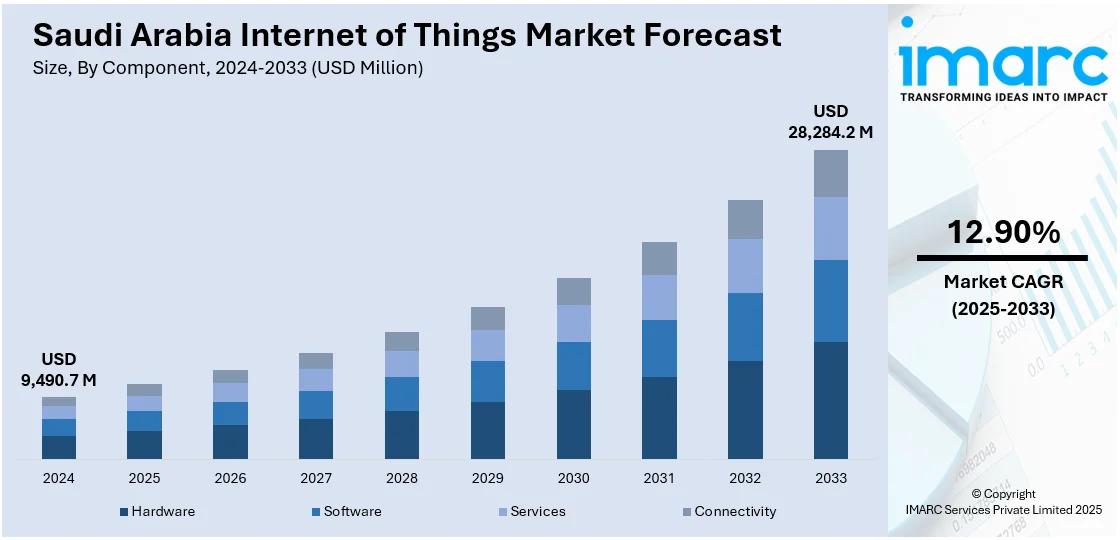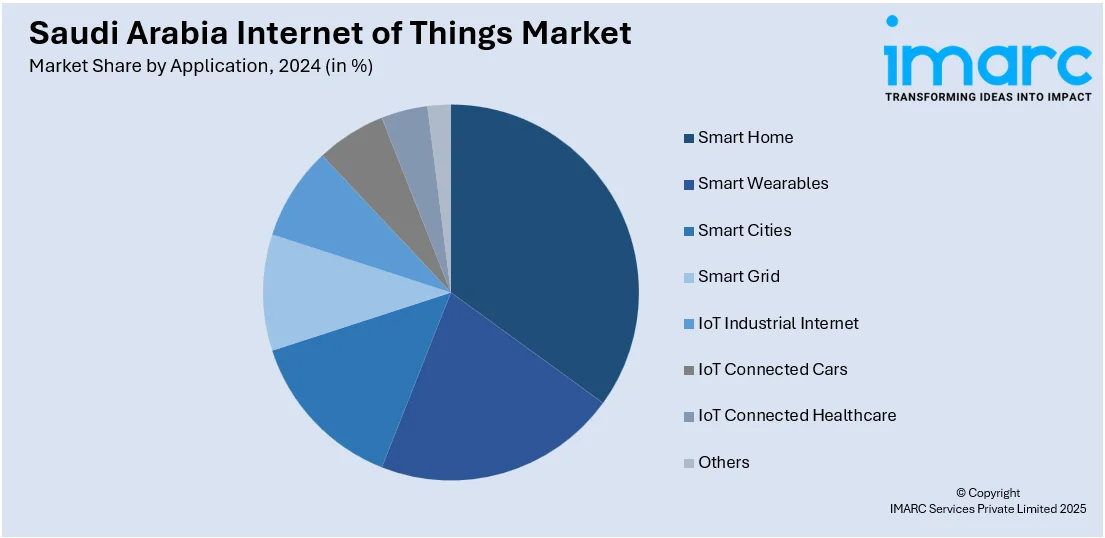
Saudi Arabia Internet of Things Market Size, Share, Trends and Forecast by Component, Application, Vertical, and Region, 2025-2033
Saudi Arabia Internet of Things Market Overview:
The Saudi Arabia internet of things market size reached USD 9,490.7 Million in 2024. Looking forward, IMARC Group expects the market to reach USD 28,284.2 Million by 2033, exhibiting a growth rate (CAGR) of 12.90% during 2025-2033. The rapid expansion of 5G, integration of artificial intelligence (AI) with Internet of Things (IoT), and the emergence of local tech ecosystems and startups are driving the growth of the market in Saudi Arabia, enabling advanced applications, fostering innovation, and positioning the country as a leader in digital transformation and industrial technology.
|
Report Attribute
|
Key Statistics
|
|---|---|
|
Base Year
|
2024 |
|
Forecast Years
|
2025-2033
|
|
Historical Years
|
2019-2024
|
| Market Size in 2024 | USD 9,490.7 Million |
| Market Forecast in 2033 | USD 28,284.2 Million |
| Market Growth Rate 2025-2033 | 12.90% |
Saudi Arabia Internet of Things Market Trends:
Rapid Expansion of 5G and Connectivity Infrastructure
The rapid deployment of 5G networks and enhancements in connectivity infrastructure are greatly enhancing the IoT market in Saudi Arabia. The high bandwidth, ultra-low latency, and extensive device connectivity that 5G provides allow for more sophisticated and real-time IoT applications to be possible in various sectors, such as autonomous mobility, remote healthcare, and industrial automation. In 2024, stc Group and Huawei launched SuperLink, a digital solution to enhance 5G connectivity in remote regions of Saudi Arabia. This technology improved 5G speeds by 200% and reduced infrastructure needs, promoting sustainability. The launch aimed to bridge the digital divide and expand high-speed connectivity across the kingdom. With the expansion of 5G coverage throughout Saudi Arabia, supported by governmental support and private sector funding, companies and local governments are increasingly assured in implementing IoT systems. By utilizing dependable, high-speed data streams, organizations can deploy extensive sensor networks, sophisticated automation, and cloud-edge integration.

Rise of AI Integration in IoT Ecosystems
The growing incorporation of AI with IoT technologies is revealing new possibilities across Saudi Arabia’s digital landscape, making IoT systems more intelligent, adaptive, and valuable. AI enhances IoT by facilitating real-time data analysis, predictive maintenance, and self-directed decision-making, greatly improving operational efficiency and service provision. In 2024, Qualcomm and Alat announced a collaboration to enhance AI and Industrial IoT solutions, positioning Saudi Arabia as a global innovation leader. The partnership focused on AI-enabled smart devices and IoT modules, with the first initiative being an AI inference accelerator card. This collaboration aimed to drive digital transformation and foster innovation in various industries. The growing synergy between AI and IoT not only enhances business intelligence but also accelerates the shift toward smart governance, autonomous operations, and advanced industrial solutions, positioning it as a key growth driver for the evolving IoT market in Saudi Arabia.
Emergence of Local Tech Ecosystems and Startups
Saudi Arabia's IoT market is experiencing considerable growth due to the swift development of local tech ecosystems, supported by startup incubation, venture funding, and government-sponsored innovation initiatives. Entrepreneurship is being vigorously fostered through programs such as accelerators, technology parks, and funding platforms, all aimed at promoting local IoT innovations. A notable instance of this is the Design in Saudi Arabia (DISA) project initiated in 2024 by Qualcomm, Aramco, and Saudi Arabia’s RDIA. The initiative provided technical assistance, intellectual property training, and entry to cutting-edge labs and platforms, specifically designed to nurture AI and IoT startups. This initiative aimed to accelerate digital transformation and boost Saudi Arabia's industrial tech ecosystem by offering the resources and knowledge required for emerging tech companies to succeed. Besides this, the partnership between major companies and startups encourages the creation of innovative IoT solutions designed for local issues, spanning from agriculture to industrial uses. Moreover, collaborations with universities and research organizations are enhancing the talent pipeline, guaranteeing a steady influx of fresh ideas and technologies. This dynamic ecosystem fosters a competitive, varied, and robust IoT market that can swiftly adjust to changing technological requirements and societal expectations, establishing Saudi Arabia as a frontrunner in industrial technology innovation.
Saudi Arabia Internet of Things Market Segmentation:
IMARC Group provides an analysis of the key trends in each segment of the market, along with forecasts at the regional level for 2025-2033. Our report has categorized the market based on component, application, and vertical.
Component Insights:
- Hardware
- Software
- Services
- Connectivity
A detailed breakup and analysis of the market based on the component have also been provided in the report. This includes hardware, software, services, and connectivity.
Application Insights:

- Smart Home
- Smart Wearables
- Smart Cities
- Smart Grid
- IoT Industrial Internet
- IoT Connected Cars
- IoT Connected Healthcare
- Others
The report has provided a detailed breakup and analysis of the market based on the application. This includes smart home, smart wearables, smart cities, smart grid, IoT industrial internet, IoT connected cars, IoT connected healthcare, and others.
Vertical Insights:
- Healthcare
- Energy
- Public and Services
- Transportation
- Retail
- Individuals
- Others
A detailed breakup and analysis of the market based on the vertical have also been provided in the report. This includes healthcare, energy, public and services, transportation, retail, individuals, and others.
Regional Insights:
- Northern and Central Region
- Western Region
- Eastern Region
- Southern Region
The report has also provided a comprehensive analysis of all the major regional markets, which include Northern and Central Region, Western Region, Eastern Region, and Southern Region.
Competitive Landscape:
The market research report has also provided a comprehensive analysis of the competitive landscape. Competitive analysis such as market structure, key player positioning, top winning strategies, competitive dashboard, and company evaluation quadrant has been covered in the report. Also, detailed profiles of all major companies have been provided.
Saudi Arabia Internet of Things Market News:
- In February 2025, Myriota partnered with Saudi Arabia’s Space and Technology Commission to expand ultra-low power satellite IoT connectivity in the kingdom. The collaboration includes smart water meter deployments in remote areas, supporting critical sectors like agriculture and utilities. This move follows Myriota’s graduation from the CST’s Emerging Technologies Regulatory Sandbox.
- In November 2024, stc Group and Dawiyat Digital signed a strategic agreement to expand IoT services across Saudi Arabia. The partnership aimed to leverage stc's extensive network to enhance IoT solutions in various sectors. This collaboration enabled smarter, more connected services for businesses and individuals.
Saudi Arabia Internet of Things Market Report Coverage:
| Report Features | Details |
|---|---|
| Base Year of the Analysis | 2024 |
| Historical Period | 2019-2024 |
| Forecast Period | 2025-2033 |
| Units | Million USD |
| Scope of the Report |
Exploration of Historical Trends and Market Outlook, Industry Catalysts and Challenges, Segment-Wise Historical and Future Market Assessment:
|
| Components Covered | Hardware, Software, Services, Connectivity |
| Applications Covered | Smart Home, Smart Wearables, Smart Cities, Smart Grid, IoT Industrial Internet, IoT Connected Cars, IoT Connected Healthcare, Others |
| Verticals Covered | Healthcare, Energy, Public and Services, Transportation, Retail, Individuals, Others |
| Regions Covered | Northern and Central Region, Western Region, Eastern Region, Southern Region |
| Customization Scope | 10% Free Customization |
| Post-Sale Analyst Support | 10-12 Weeks |
| Delivery Format | PDF and Excel through Email (We can also provide the editable version of the report in PPT/Word format on special request) |
Key Questions Answered in This Report:
- How has the Saudi Arabia internet of things market performed so far and how will it perform in the coming years?
- What is the breakup of the Saudi Arabia internet of things market on the basis of component?
- What is the breakup of the Saudi Arabia internet of things market on the basis of application?
- What is the breakup of the Saudi Arabia internet of things market on the basis of vertical?
- What is the breakup of the Saudi Arabia internet of things market on the basis of region?
- What are the various stages in the value chain of the Saudi Arabia internet of things market?
- What are the key driving factors and challenges in the Saudi Arabia internet of things market?
- What is the structure of the Saudi Arabia internet of things market and who are the key players?
- What is the degree of competition in the Saudi Arabia internet of things market?
Key Benefits for Stakeholders:
- IMARC’s industry report offers a comprehensive quantitative analysis of various market segments, historical and current market trends, market forecasts, and dynamics of the Saudi Arabia internet of things market from 2019-2033.
- The research report provides the latest information on the market drivers, challenges, and opportunities in the Saudi Arabia internet of things market.
- Porter's five forces analysis assist stakeholders in assessing the impact of new entrants, competitive rivalry, supplier power, buyer power, and the threat of substitution. It helps stakeholders to analyze the level of competition within the Saudi Arabia internet of things industry and its attractiveness.
- Competitive landscape allows stakeholders to understand their competitive environment and provides an insight into the current positions of key players in the market.
Need more help?
- Speak to our experienced analysts for insights on the current market scenarios.
- Include additional segments and countries to customize the report as per your requirement.
- Gain an unparalleled competitive advantage in your domain by understanding how to utilize the report and positively impacting your operations and revenue.
- For further assistance, please connect with our analysts.
 Request Customization
Request Customization
 Speak to an Analyst
Speak to an Analyst
 Request Brochure
Request Brochure
 Inquire Before Buying
Inquire Before Buying




.webp)




.webp)












